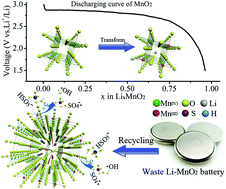当前位置:
X-MOL 学术
›
Green Chem.
›
论文详情
Our official English website, www.x-mol.net, welcomes your
feedback! (Note: you will need to create a separate account there.)
Recycling application of waste Li–MnO2 batteries as efficient catalysts based on electrochemical lithiation to improve catalytic activity
Green Chemistry ( IF 9.3 ) Pub Date : 2018-09-18 , DOI: 10.1039/c8gc02183j Xu Wang 1, 2, 3, 4 , Haijun Qiu 1, 2, 3, 4 , Haolin Liu 1, 2, 3, 4 , Penghui Shi 1, 2, 3, 4, 5 , Jinchen Fan 1, 2, 3, 4 , Yulin Min 1, 2, 3, 4 , Qunjie Xu 1, 2, 3, 4, 5
Green Chemistry ( IF 9.3 ) Pub Date : 2018-09-18 , DOI: 10.1039/c8gc02183j Xu Wang 1, 2, 3, 4 , Haijun Qiu 1, 2, 3, 4 , Haolin Liu 1, 2, 3, 4 , Penghui Shi 1, 2, 3, 4, 5 , Jinchen Fan 1, 2, 3, 4 , Yulin Min 1, 2, 3, 4 , Qunjie Xu 1, 2, 3, 4, 5
Affiliation

|
The ever-increasing consumption of tons of lithium batteries, for example, Li–MnO2 batteries, has generated great concern regarding their recycling. Currently, the developed or proposed cathode recycling processes often suffer from complex recycling procedures, potential secondary pollution, high operating costs, or thermal reprocessing. The discharge of Li–MnO2 batteries involves electrochemical lithiation, which is simultaneously accompanied by the transition from Mn(IV) to Mn(III). Studies on manganese-containing catalysts have experimentally and theoretically emphasized the role of Mn(III) as an important intermediate state for enabling catalytic reactions. We present herein a simple washing-recycling process for efficiently recycling the MnO2-based cathode materials as catalysts from depleted lithium batteries. The multiple important properties of the lithiated MnO2, including phase structure, oxidation state, surface oxygen species, and structural factors, were investigated in detail. Correspondingly, the effect of the degree of electrochemical lithiation on the catalytic activity of recycled MnO2 was observed to be continuously tuned. Compared with pristine MnO2, the recycled MnO2 exhibited remarkably enhanced catalytic activity for activating PMS to decompose contaminants. The catalytic activity was correlated with the composition of LixMnO2 generated in situ in Li–MnO2 batteries owing to the tuning of the Mn valence and structural factors. This study provides an attractive method for converting the depleted electrode materials of lithium batteries into catalysts to enhance their recycling efficiency.
中文翻译:

废Li–MnO 2电池作为基于电化学锂化的有效催化剂的循环利用,以提高催化活性
锂电池(例如,Li–MnO 2电池)的吨消耗量不断增加,引起了人们对其回收利用的极大关注。当前,已开发或提议的阴极回收工艺通常遭受复杂的回收程序,潜在的二次污染,高运行成本或热后处理的困扰。Li-MnO 2电池的放电涉及电化学锂化,同时伴随着从Mn(IV)到Mn(III)的转变。含锰催化剂的研究在理论上和实验上都强调了Mn(III)作为促进催化反应的重要中间状态。我们在此提出一种简单的洗涤-再循环方法,以有效地再循环基于MnO 2的阴极材料作为来自耗尽锂电池的催化剂。详细研究了锂化MnO 2的多个重要特性,包括相结构,氧化态,表面氧种类和结构因素。相应地,观察到电化学锂化程度对回收的MnO 2的催化活性的影响是连续调整的。与原始MnO 2相比,回收的MnO 2表现出显着增强的催化活性,可激活PMS分解污染物。由于Mn化合价和结构因子的调节,催化活性与Li–MnO 2电池中原位生成的Li x MnO 2的组成相关。这项研究提供了一种有吸引力的方法,可将锂电池的贫乏电极材料转化为催化剂,以提高其回收效率。
更新日期:2018-10-30
中文翻译:

废Li–MnO 2电池作为基于电化学锂化的有效催化剂的循环利用,以提高催化活性
锂电池(例如,Li–MnO 2电池)的吨消耗量不断增加,引起了人们对其回收利用的极大关注。当前,已开发或提议的阴极回收工艺通常遭受复杂的回收程序,潜在的二次污染,高运行成本或热后处理的困扰。Li-MnO 2电池的放电涉及电化学锂化,同时伴随着从Mn(IV)到Mn(III)的转变。含锰催化剂的研究在理论上和实验上都强调了Mn(III)作为促进催化反应的重要中间状态。我们在此提出一种简单的洗涤-再循环方法,以有效地再循环基于MnO 2的阴极材料作为来自耗尽锂电池的催化剂。详细研究了锂化MnO 2的多个重要特性,包括相结构,氧化态,表面氧种类和结构因素。相应地,观察到电化学锂化程度对回收的MnO 2的催化活性的影响是连续调整的。与原始MnO 2相比,回收的MnO 2表现出显着增强的催化活性,可激活PMS分解污染物。由于Mn化合价和结构因子的调节,催化活性与Li–MnO 2电池中原位生成的Li x MnO 2的组成相关。这项研究提供了一种有吸引力的方法,可将锂电池的贫乏电极材料转化为催化剂,以提高其回收效率。










































 京公网安备 11010802027423号
京公网安备 11010802027423号